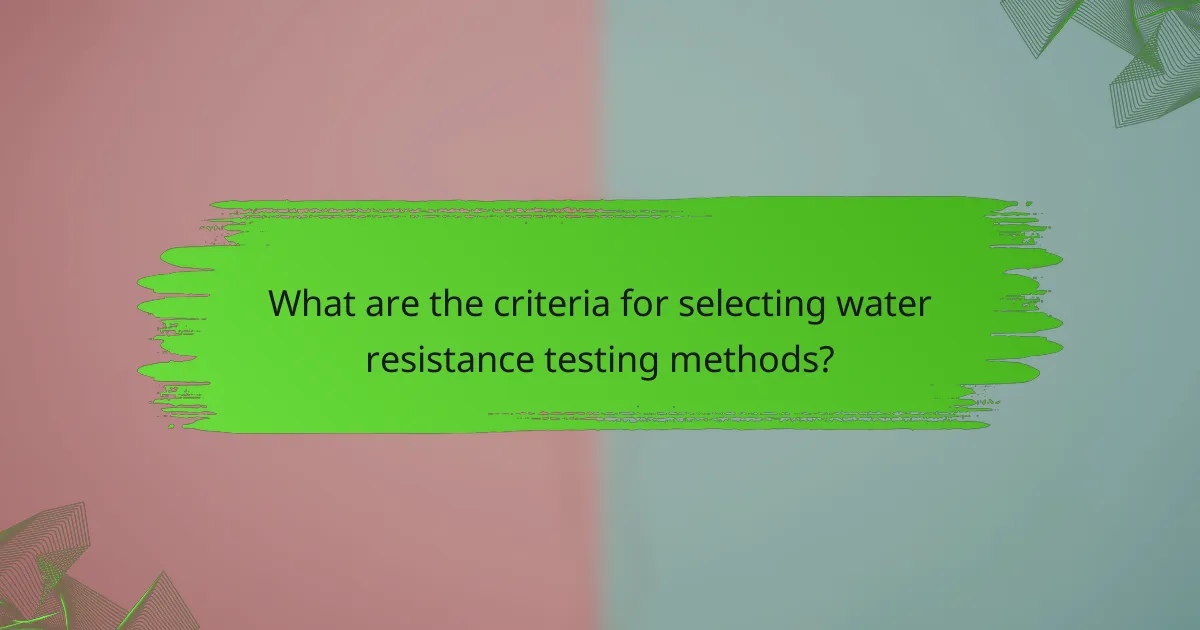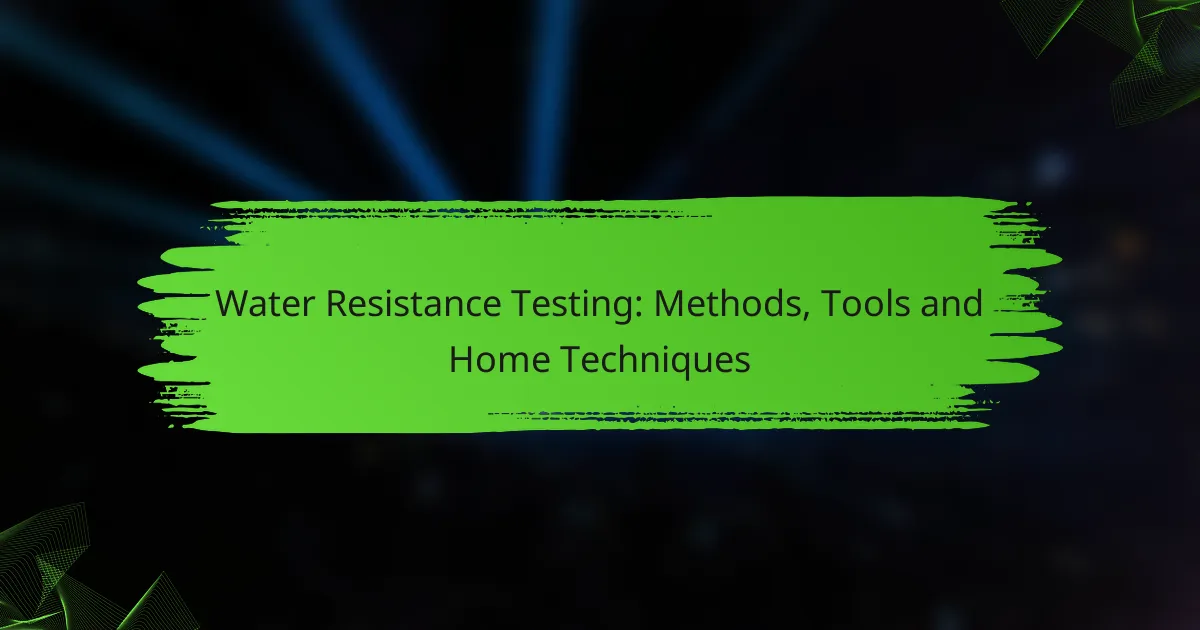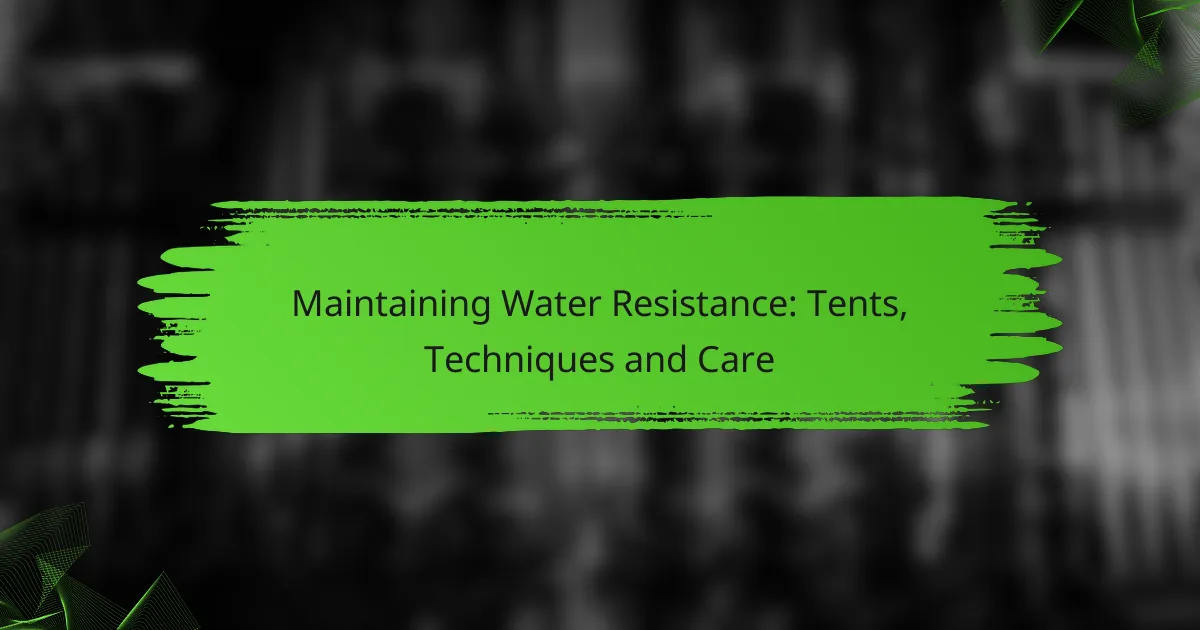Water resistance testing is crucial for evaluating how well products can withstand exposure to moisture, ensuring their reliability and durability. Various methods, such as pressure testing and submersion testing, are employed alongside specialized tools to assess the effectiveness of seals and materials. For those looking to test items at home, simple techniques can provide insights into their water resistance without the need for professional equipment.

What are the best methods for water resistance testing?
The best methods for water resistance testing include pressure testing, submersion testing, spray testing, vapor testing, and dynamic testing. Each method evaluates how well a product can withstand water exposure under different conditions, helping manufacturers ensure reliability and durability.
Pressure testing
Pressure testing involves subjecting a product to water under controlled pressure to assess its ability to resist leaks. This method is commonly used for items like watches and electronic devices, where water can penetrate through seals or gaskets. Typically, pressure is applied in a range from a few atmospheres to several dozen, depending on the product’s specifications.
When conducting pressure tests, it’s crucial to follow industry standards, such as ISO 2281 for watches, to ensure accurate results. Avoid exceeding the recommended pressure limits, as this can damage the product and yield misleading outcomes.
Submersion testing
Submersion testing evaluates a product’s water resistance by fully immersing it in water for a specified duration. This method is effective for assessing how well a product can handle prolonged exposure to water. Common practice involves submerging the item for anywhere from a few minutes to several hours, depending on its intended use.
To perform this test, ensure that the water temperature and conditions mimic real-world scenarios. After submersion, inspect the product for any signs of water ingress, which can indicate failure in seals or materials.
Spray testing
Spray testing simulates exposure to water from rain or splashes by using a spray nozzle to direct water at the product. This method is particularly relevant for outdoor gear and electronics that may encounter wet conditions. The testing duration and water pressure can vary, typically ranging from light mist to heavy spray.
It’s important to maintain a consistent distance and angle during spray testing to ensure uniform exposure. Products should be evaluated for water penetration after testing, focusing on vulnerable areas like seams and openings.
Vapor testing
Vapor testing assesses a product’s ability to resist moisture in the form of vapor, which can be critical for items like clothing and footwear. This method involves placing the product in a controlled environment with high humidity and measuring moisture penetration over time. The results help determine breathability and moisture management properties.
When conducting vapor tests, use standardized equipment to create a consistent environment. Pay attention to the material’s permeability rating, which indicates how well it can manage moisture without allowing water to pass through.
Dynamic testing
Dynamic testing evaluates water resistance under real-world conditions by simulating movement or impact while exposed to water. This method is essential for products like sports watches or outdoor electronics that may face splashes during activities. Testing often involves moving the product through water or subjecting it to vibrations while wet.
For effective dynamic testing, replicate the conditions the product will face in actual use. Monitor for any water ingress during and after the test to assess the effectiveness of seals and materials under stress.

What tools are essential for water resistance testing?
Essential tools for water resistance testing include specialized machines and devices designed to assess how well products can withstand water exposure. These tools help determine the effectiveness of seals and materials in preventing water ingress.
Waterproof testing machines
Waterproof testing machines are designed to simulate various water exposure conditions, allowing manufacturers to evaluate the durability of their products. These machines can replicate different levels of water pressure and immersion times, providing a comprehensive assessment of water resistance.
When selecting a waterproof testing machine, consider factors such as the maximum pressure it can simulate and the types of products it can accommodate. It’s essential to ensure that the machine complies with relevant industry standards for accurate results.
Hydrostatic pressure testers
Hydrostatic pressure testers measure the resistance of materials to water under pressure. This method involves applying water pressure to a sample and observing any leaks or failures, which helps in assessing the integrity of seals and joints.
These testers are particularly useful for evaluating products like outdoor gear, electronics, and automotive components. Ensure that the tester can reach the necessary pressure levels for your specific application, typically ranging from a few hundred to several thousand pascals.
Water leak detectors
Water leak detectors are devices that identify the presence of moisture or water ingress in products. They can be used in conjunction with other testing methods to provide real-time feedback on the effectiveness of water-resistant features.
Look for detectors that offer sensitivity adjustments and can detect both liquid water and humidity levels. These tools are valuable for ensuring that products meet quality standards and can prevent costly damages from leaks.
Digital multimeters
Digital multimeters are versatile tools that can measure various electrical properties, including resistance, voltage, and current. In the context of water resistance testing, they can help assess the integrity of electronic components after exposure to moisture.
When using a digital multimeter, ensure it has a waterproof rating if it will be used in wet conditions. Regularly calibrate the device to maintain accuracy, especially when testing sensitive electronic equipment.

How can I test water resistance at home?
You can test water resistance at home using simple methods that require minimal tools. These techniques help you determine how well an item can withstand exposure to moisture without professional equipment.
Using a zip-lock bag
A zip-lock bag is a straightforward tool for testing water resistance. Place the item you want to test inside the bag, seal it tightly, and submerge it in water for a short period, typically around 30 minutes. Afterward, check the bag for any signs of moisture inside.
This method is particularly useful for electronic devices. Ensure the bag is completely sealed to avoid water ingress, and remember that prolonged exposure can lead to inaccuracies in the test.
DIY submersion test
The DIY submersion test involves fully immersing the item in water for a set time. Choose a container large enough to hold the item and fill it with water. Submerge the item for a few minutes, then remove it and dry it off to check for any water damage.
Be cautious with this method, especially for electronics. If the item is not rated for water resistance, even brief exposure could cause damage. Always consult the manufacturer’s guidelines if available.
Soap and water method
The soap and water method is effective for testing fabrics and materials. Mix a small amount of soap with water and apply it to the surface of the item. Observe how the water beads or penetrates the material.
This technique is particularly useful for clothing or outdoor gear. If the soap solution easily soaks into the fabric, it may indicate that the item lacks sufficient water resistance. Rinse the item afterward to remove any soap residue.

What are the criteria for selecting water resistance testing methods?
Selecting water resistance testing methods involves considering factors such as material compatibility, testing environment, and accuracy requirements. These criteria ensure that the chosen method effectively evaluates the water resistance of a product while aligning with its intended use and performance standards.
Material compatibility
Material compatibility is crucial when selecting a water resistance testing method, as different materials respond uniquely to water exposure. For instance, textiles, metals, and plastics may require distinct testing protocols to accurately assess their water resistance. Always ensure that the testing method does not compromise the integrity of the material being tested.
For example, fabrics might be tested using spray tests or immersion tests, while electronic devices may require specific environmental conditions to prevent damage during testing. Understanding the material’s properties helps in choosing the right method.
Testing environment
The testing environment significantly impacts the results of water resistance evaluations. Factors such as temperature, humidity, and pressure can alter the performance of materials under water exposure. Ideally, testing should mimic real-world conditions to provide accurate assessments.
For example, if a product is intended for outdoor use in humid climates, testing should occur in similar conditions. Additionally, controlled laboratory settings can help standardize results, but they may not always reflect actual usage scenarios.
Accuracy requirements
Accuracy requirements dictate how precise the water resistance testing needs to be for a specific application. Depending on the product, different levels of accuracy may be necessary; for instance, consumer products may require less stringent testing than critical components in aerospace or medical devices.
Establish clear benchmarks for acceptable water resistance levels based on industry standards or regulatory requirements. For example, a common standard for outdoor gear is a water column rating, which measures the pressure a fabric can withstand before leaking. Understanding these requirements helps in selecting the appropriate testing method and ensuring reliable results.

What are the common applications of water resistance testing?
Water resistance testing is crucial for ensuring that products can withstand exposure to moisture without compromising functionality. Common applications include testing watches, electronic devices, clothing, and outdoor gear to verify their durability and reliability in wet conditions.
Watches
Water resistance testing for watches determines how well they can withstand exposure to water. This is typically classified into levels, such as 30 meters for splash resistance and up to 300 meters for professional diving watches. Consumers should consider the intended use of the watch when selecting the appropriate water resistance rating.
Common pitfalls include assuming that a watch is waterproof without checking its specifications. Regular maintenance and testing are recommended, especially for watches used in water sports.
Electronic Devices
For electronic devices, water resistance testing evaluates how well they can resist water ingress, which is essential for devices like smartphones and tablets. Ratings such as IP67 indicate that a device can withstand immersion in water up to 1 meter for a limited time. Users should be aware that water resistance can diminish over time due to wear and tear.
It is advisable to avoid exposing devices to water unless they are explicitly rated for it. Using protective cases can enhance water resistance but should not be solely relied upon.
Clothing and Outdoor Gear
Water resistance testing for clothing and outdoor gear assesses how well materials repel water. This is particularly important for jackets, tents, and footwear designed for wet conditions. Ratings often indicate the level of water pressure a fabric can withstand, such as 5,000 mm for light rain to 20,000 mm for heavy downpours.
When selecting waterproof clothing, consider factors like breathability and comfort. Regularly treating fabrics with water repellent sprays can help maintain their effectiveness over time.



